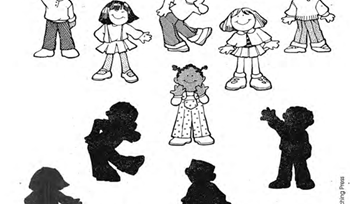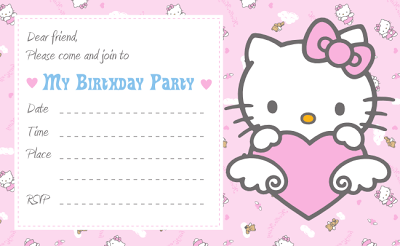Counting for children is the foundation on which we build mathematical skills, and counting activities offer a range of simple yet highly engaging activities that provide them with a hands-on way to develop such skills. From toddlers stacking blocks to preschoolers sorting buttons, this activity can be tailored to suit different age groups and developmental stages, making it a versatile learning tool. Beyond the educational benefits, doing counting activities together fosters social interaction, encouraging teamwork, communication, and shared focus. By turning counting into a playful and collaborative experience, parents and caregivers can strengthen bonds and nurture a child’s confidence in their growing abilities.
In this article, we will talk about the benefits of counting activities for your young learners and point you to some great resources to get started. There will also be some great invitation templates at the end, for you to download and use if you are planning to invite other parents with young children to a counting playdates, because the more the merrier!

Benefits of Counting Activities for Children
Counting with items offers a range of benefits that contribute to a child’s overall development, particularly in the areas of math, cognitive skills, and social interaction. Here are some key benefits of this activity:
1. Enhances Math Skills
Counting activities offer a range of benefits that contribute to a child’s overall development, particularly in math, cognitive skills, and social interaction. One of the primary advantages is the enhancement of math skills. As children count objects, they begin to understand number recognition and the relationship between numbers and quantities. This activity also helps lay the foundation for basic math operations like addition and subtraction, while also introducing the concept of one-to-one correspondence—the idea that each object should be counted once. As children grow, these counting skills provide a solid base for more advanced mathematical concepts, such as multiplication and division.
2. Improves Cognitive Development
Beyond math, counting activities also support cognitive development. The activity requires children to focus, follow a sequence, and stay engaged, which improves their attention span and concentration. Additionally, counting challenges children to solve problems, whether it’s figuring out how many objects are in a group or grouping them in different ways. This problem-solving practice strengthens their critical thinking and memory, as they retain and recall numerical information.
3. Develops Fine Motor Skills
Coupling the counting worksheets with engaging physical objects and everyday items will also enhance a child’s fine motor skills. Handling small items like buttons, blocks, or coins helps children develop hand-eye coordination, a key component of many other skills, including writing and drawing. Furthermore, counting activities contribute to language development.
4. Fosters Language Development
As children count aloud or talk about the items they are counting, they build their vocabulary and practice communication skills. This aspect of the activity is particularly beneficial for younger children, who are still expanding their language abilities.
5. Supports Social Skills
Social skills are also greatly impacted by counting activities. When children engage in counting together, whether in pairs or small groups, they learn how to collaborate and work toward a shared goal. This helps them practice turn-taking, following directions, and asking for help. Through these interactions, children also develop empathy and patience, as they learn to share materials and cooperate with others.
6. Encourages Creativity and Builds Confidence
Counting activities also spark creativity. Children can create patterns, make sequences, or even tell stories using the items they are counting, which encourages imaginative thinking. Finally, mastering the concept of counting and achieving milestones boosts a child’s confidence. Successfully completing counting tasks gives children a sense of accomplishment, which fosters a positive attitude toward learning and encourages further exploration.
Different counting activity worksheets incorporate different things: coloring, drawing and even handling everyday objects. This way, learning is not only beneficial but also enjoyable, providing a solid foundation for further mathematical exploration and social development.
Counting Activity Worksheets
Count and Match
Count and match activities are perfect for toddlers as they combine early math learning with hands-on play, making the experience both educational and enjoyable. This activity helps toddlers develop their understanding of numbers and quantities by encouraging them to match items to corresponding numbers or groups. Check out this count and match worksheet from Fun Learning Hub, it is a great one to start off with!
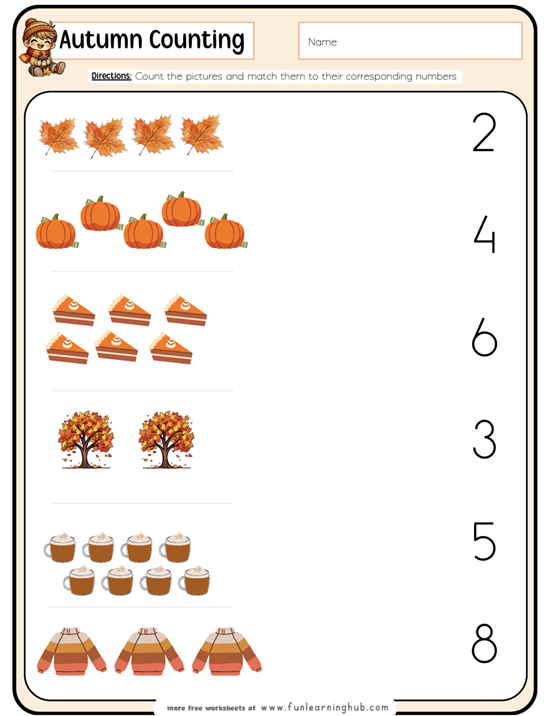
You can also use toys and everyday items in this activity. For instance, they might count and place three toy cars next to the number 3 or match a group of apples to a picture of an equal number. These tasks build foundational skills like one-to-one correspondence, which is essential for later math concepts. Additionally, handling objects to count and match enhances fine motor skills and hand-eye coordination.
Count and Color
Count and color activities are an excellent way to introduce toddlers to numbers and colors while sparking their creativity. In this activity, children count objects, such as balloons, stars, or animals, on a worksheet and then color them in. Head to Fun Learning Hub for some really fun count and color worksheets.
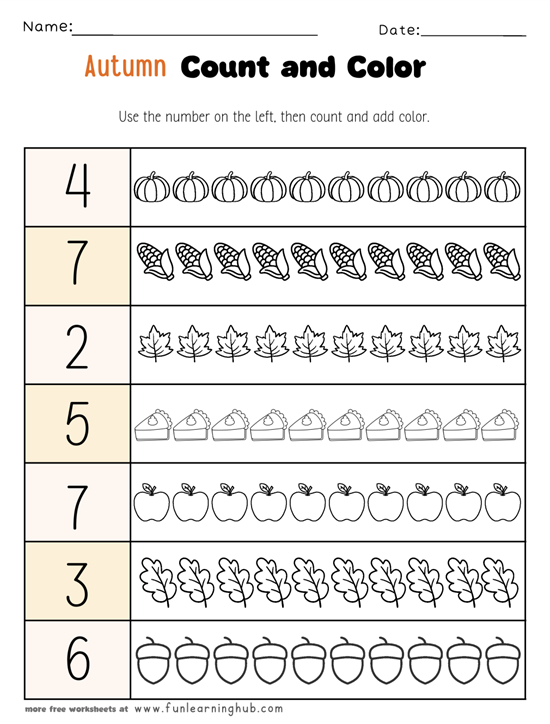
At the same time, the act of coloring improves their fine motor skills, hand-eye coordination, and grip strength, all of which are important for writing and drawing later on. The use of bright colors and engaging illustrations captures toddlers’ attention, keeping them focused while they practice foundational skills. Count and color also encourages self-expression as children choose their favorite colors, making learning both enjoyable and meaningful.
Count and Draw or Write
These types of worksheets are for older children, those in kindergarten, when they have better control over writing instruments and when they are already learning how to write their numbers. This worksheet from Semesta Ibu is a fun one where they count the number of different types of leaves and write the number in the space provided.
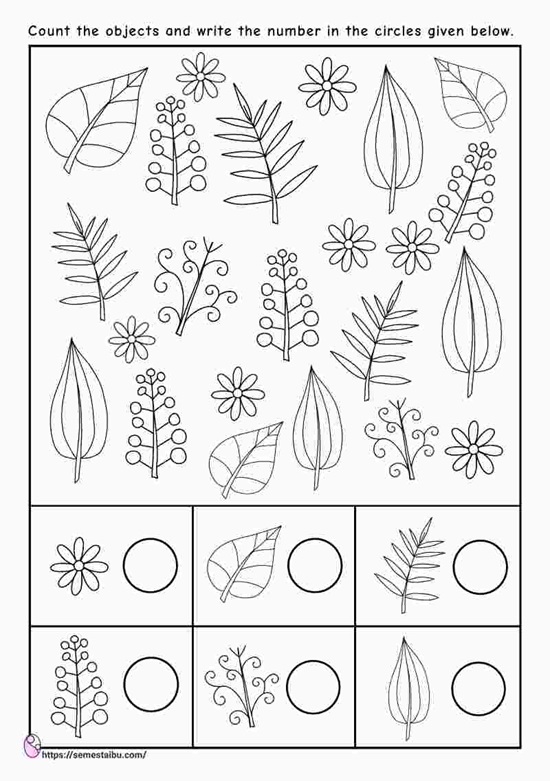
Another one from Semesta Ibu is this worksheet where children are given a number and then they are required to draw leaves of that exact amount. Check out the worksheet right here: Counting Worksheet | Drawing Leaves | BW. Worksheets like this are such a great way to encourage children to practice counting, and at the same time to spark their creativity, allowing them to draw different shapes of leaves and color them too!
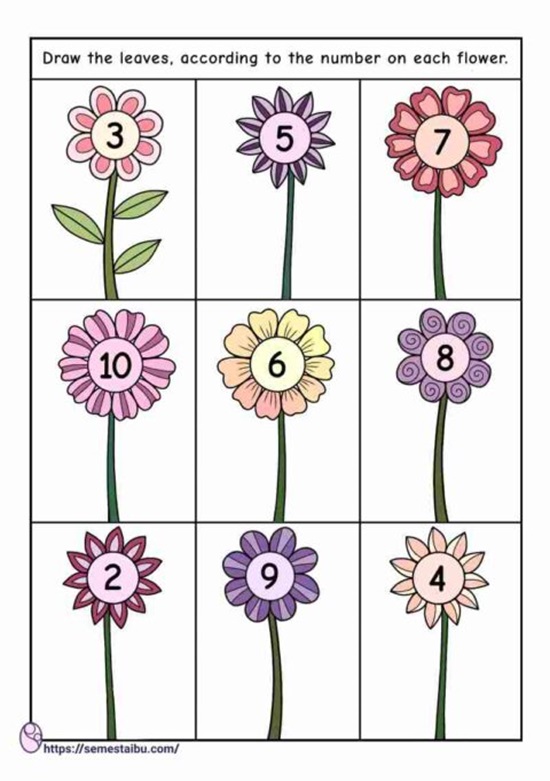
Number Puzzles
Number puzzles are such fantastic counting activities for toddlers because they combine problem-solving with hands-on learning, making early math skills engaging and fun. These puzzles typically involve matching numbers to corresponding quantities, arranging number pieces in order, or fitting numbers into a sequence on a board. This sample of number puzzle template is from Little Dots Education, head over to their The Very Hungry Caterpillar Theme: Free Counting Puzzles Printable.
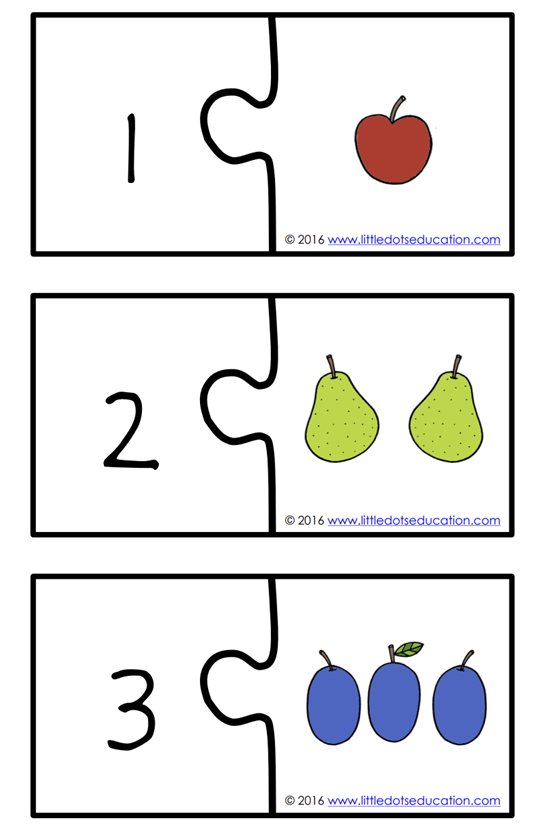
As toddlers manipulate the puzzle pieces, they not only practice counting but also develop fine motor skills and hand-eye coordination. Additionally, number puzzles encourage critical thinking as toddlers figure out where each piece fits, laying the groundwork for logical reasoning. With colorful designs and interactive play, number puzzles make counting an exciting and rewarding experience for toddlers.
Counting Activities Playdate
Doing counting activities with other children offers additional social and developmental benefits. When children engage in these activities together, they not only strengthen their math skills but also improve their ability to communicate, collaborate, and solve problems as a group. By counting alongside peers, children learn to share resources, take turns, and negotiate, which are all vital components of social interaction. This cooperative play encourages teamwork and helps children understand the value of working together to achieve a common goal. Moreover, children are more likely to stay engaged and excited about the activity when it’s a shared experience, as the social aspect adds a layer of fun and motivation.
Organizing a counting activity with other children can be a wonderful way to strengthen friendships and build a supportive community. It provides an opportunity to meet other families and foster connections through shared experiences. Parents can take turns hosting or organizing these activities, which encourages mutual involvement and collaboration.
To invite other parents to join in, one effective approach is to reach out through playgroups, neighborhood networks, or social media groups dedicated to local parenting. Parents can create a simple invitation that highlights the fun and educational aspects of the activity, as well as the opportunity for children to socialize and develop key skills. Offering a variety of counting materials—such as toys, blocks, or everyday objects—can also make it more accessible for different age groups and learning levels.

You can use our invitation templates to invite family and friends to your Counting Activities Playdate! These templates have fun designs that children will like, all you have to do is download and edit in the details of the party. By inviting other parents to participate, families can create a regular, fun, and enriching experience for children, helping them build both their mathematical abilities and their social skills in a supportive and collaborative environment.
Conclusion
Counting Activities are not only fun and engaging but also an essential tool for developing key skills in children. Whether done alone or with others, it promotes math proficiency, cognitive growth, and fine motor development. When children participate in counting activities with their peers, they gain valuable social benefits, such as learning to share, communicate, and collaborate. The experience fosters teamwork and enhances creativity, as children observe and learn from one another. Furthermore, counting together helps build confidence and boosts each child’s sense of accomplishment as they work toward a common goal.
For parents, organizing counting activities with other families offers an opportunity to create lasting connections and build a strong support network. It’s an enjoyable way for children to interact, share experiences, and learn from one another in a fun, collaborative environment. By inviting others to join in, parents can turn a simple activity into a regular bonding experience that benefits both children and families. With its many advantages, counting with items is a powerful tool for nurturing young learners and fostering a sense of community among families.

